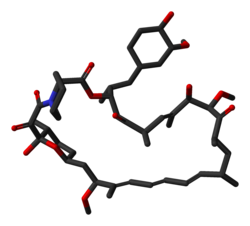 | |
 | |
| Clinical data | |
|---|---|
| Trade names | Rapamune |
| Other names | Rapamycin |
| License data | |
| Pregnancy category |
|
| Routes of administration | By mouth |
| Drug class | mTOR inhibitor[1] |
| Legal status | |
| Legal status |
|
| Pharmacokinetic data | |
| Bioavailability | 14% (oral solution), lower with high-fat meals; 18% (tablet), higher with high-fat meals[2] |
| Protein binding | 92% |
| Metabolism | Hepatic |
| Elimination half-life | 57–63 hours[3] |
| Excretion | Mostly faecal |
| Identifiers | |
| |
| Chemical and physical data | |
| Formula | C51H79NO13 |
| Molar mass | 914.187 g·mol−1 |
| 3D model (JSmol) | |
| Solubility in water | 0.0026 [4] mg/mL (20 °C) |
| |
| |
| (verify) | |
Sirolimus, also known as rapamycin, is a medication primarily used to prevent organ transplant rejection and treat lymphangioleiomyomatosis.[1][5] For kidney transplant it is a second line treatment.[6] It is taken by mouth.[1]
Common side effects include infection, fever, poor wound healing, diabetes, protein in the urine, rash, and swelling.[5] Other side effects may include lymphoma, anaphylaxis, angioedema, kidney problems, and progressive multifocal leukoencephalopathy.[1] It is an mTOR inhibitor and works by decreasing the activation of T cells and B cells.[1]
Sirolimus was isolated in 1972 and approved for medical use in the United States in 1999 and Europe in 2001.[1][7][5] It is available as a generic medication. A month of treatment in the United States at 2 mg per day costs about 225 USD as of 2021.[8] This amount in the United Kingdom costs the NHS £172 as of 2023.[9] It is sold under the brand name Rapamune.[1]
References
edit- ^ a b c d e f g h "Sirolimus Monograph for Professionals". Drugs.com. Archived from the original on 13 August 2020. Retrieved 12 October 2021.
- ^ Buck ML (2006). "Immunosuppression With Sirolimus After Solid Organ Transplantation in Children". Pediatric Pharmacotherapy. 12 (2). Archived from the original on 18 April 2020. Retrieved 11 June 2021.
- ^ "Rapamycin". PubChem Compound. National Center for Biotechnology Information. Archived from the original on 16 August 2016. Retrieved 1 August 2016.
- ^ Simamora P, Alvarez JM, Yalkowsky SH (February 2001). "Solubilization of rapamycin". International Journal of Pharmaceutics. 213 (1–2): 25–9. doi:10.1016/s0378-5173(00)00617-7. PMID 11165091.
- ^ a b c d e "Rapamune". Archived from the original on 13 August 2021. Retrieved 12 October 2021.
- ^ BNF (80 ed.). BMJ Group and the Pharmaceutical Press. September 2020 – March 2021. ISBN 978-0-85711-369-6.
{{cite book}}: CS1 maint: date format (link) - ^ Seto B (November 2012). "Rapamycin and mTOR: a serendipitous discovery and implications for breast cancer". Clinical and Translational Medicine. 1 (1): 29. doi:10.1186/2001-1326-1-29. PMC 3561035. PMID 23369283.
{{cite journal}}: CS1 maint: unflagged free DOI (link) - ^ "Sirolimus Prices, Coupons & Savings Tips - GoodRx". GoodRx. Retrieved 12 October 2021.
- ^ "8. Immune system and malignant disease". BNF 86: September 2023 - March 2024. BMJ Group and the Pharmaceutical Press. 2023. pp. 925–926. ISBN 978-0857114617.